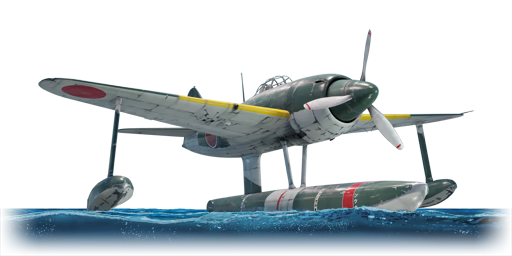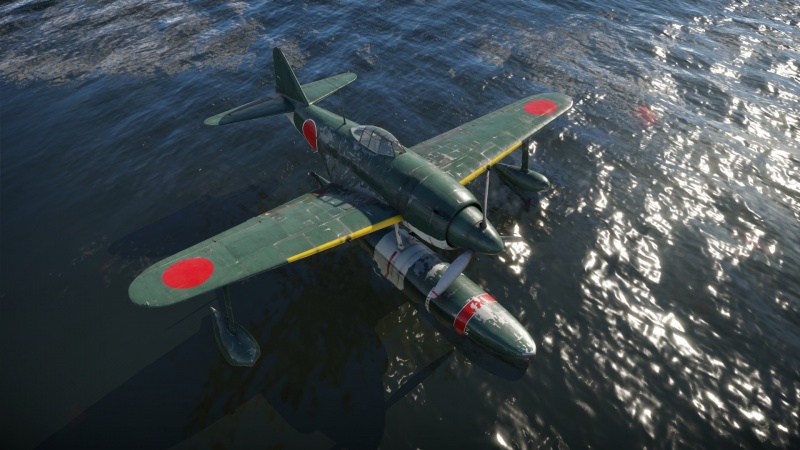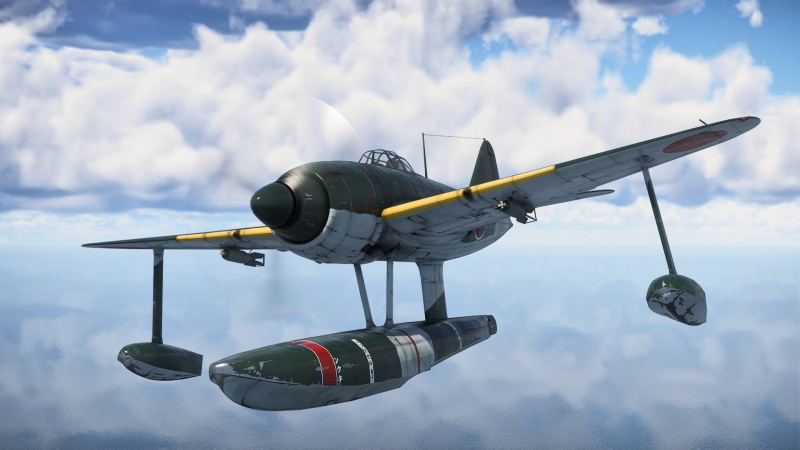N1K1
| This page is about the Japanese fighter N1K1. For other versions, see N1K (Family). |
Contents
Description
The N1K1, designated as Kyōfū (強風), was a floatplane fighter designed by Kawanishi Aircraft Company for the Imperial Japanese Navy in 1940. It was intended to support offensive operations in areas where no airstrips were available, but by the time it entered service in 1943, Japan was on the defensive and had little need for such a fighter. The N1K1 Kyofu was powered by a Mitsubishi MK4C Kasei 13 engine and had a top speed of 489 km/h. It was armed with two 7.7 mm machine guns and two 20 mm cannons. It saw limited service in Southeast Asia, Okinawa and Lake Biwa, where it faced superior Allied fighters. The N1K1 Kyofu was also the basis of a land-based version, the N1K-J Shiden (紫電), considered one of the finest Japanese fighters of World War II.
The N1K1 Kyōfū was introduced in Update 1.65 "Way of the Samurai". It is a top-notch fighter seaplane, with better flight performance, more 20 mm ammo, and self-sealing fuel tanks than the previous A6M2-N. However, it is not a beginner-friendly plane, as the floats still affect its performance, and energy management is crucial to avoid being an easy target.
- Nicknames
- Official Designation: 強風 (Kyōfū, "Strong Wind")
- Allied reporting name: Rex
General info
Flight performance
The N1K1 doesn't have great flight characteristics. With an average turn time and rate of climb, it can struggle against other planes at its BR.
| Characteristics | Max Speed (km/h at 6,000 m) |
Max altitude (metres) |
Turn time (seconds) |
Rate of climb (metres/second) |
Take-off run (metres) | |||
|---|---|---|---|---|---|---|---|---|
| AB | RB | AB | RB | AB | RB | |||
| Stock | 473 | 462 | 10000 | 19.9 | 20.6 | 11.5 | 11.5 | 500 |
| Upgraded | 507 | 489 | 18.1 | 19.0 | 19.2 | 14.9 | ||
Details
| Features | ||||
|---|---|---|---|---|
| Combat flaps | Take-off flaps | Landing flaps | Air brakes | Arrestor gear |
| ✓ | ✓ | ✓ | X | X |
| Limits | ||||||
|---|---|---|---|---|---|---|
| Wings (km/h) | Gear (km/h) | Flaps (km/h) | Max Static G | |||
| Combat | Take-off | Landing | + | - | ||
| 600 | 600 | 394 | 387 | 350 | ~7 | ~7 |
| Optimal velocities (km/h) | |||
|---|---|---|---|
| Ailerons | Rudder | Elevators | Radiator |
| < 430 | < 300 | < 400 | > 324 |
Survivability and armour
The survivability of the N1K1 is typical of Japanese planes and not to be relied on. With non-effective self-sealing fuel tanks, it won't survive many shots, especially if it catches on fire.
Modifications and economy
Armaments
Offensive armament
The N1K1 is armed with:
- 2 x 20 mm Type 99 Model 1 cannons, wing-mounted (100 rpg = 200 total)
- 2 x 7.7 mm Type 97 navy machine guns, nose-mounted (550 rpg = 1,100 total)
Suspended armament
The N1K1 can be outfitted with the following ordnance:
- Without load
- 2 x 60 kg Navy Type 97 Number 6 bombs (120 kg total)
Usage in battles
N1K1 is considered as best fighter seaplane available in War Thunder, and if you are experienced or mastered the previous A6M2-N, you will be satisfied with the improved flight performance, generous ammo count for 20 mm cannons, and self-sealing fuel tanks to minimize the fire eats up your entire fuselage.
Despite the features it offers, N1K1 is not designed for beginners as the floats still hamper the plane's performance, and without proper knowledge of energy retention management, you'll be a sitting duck in no time.
- N1K1 is a versatile fighter seaplane, it can do both support and ground-pound roles. While so, this plane shines when it comes to fulfilling air superiority. During the engagement, make sure to utilize the flaps at the right moment, as the flaps will break beyond 380 km/h. Although N1K1 is boom-and-zoom capable, never attempt to dive beyond 600 km/h or you might break one of your wings and loses your flight control.
- The generous ammo count of 20 mm improves your sustained fight performance over the A6M2-N. To improve its deadliness, set the gun targeting distance at 150-250 m which is desired for boom-and-zoom or dogfighting purposes. While technically all the ammo of the 20 mm cannons is useful to take down the target including the default belt, it is advised to pick Universal or Stealth ammo for the 7.7 mm.
- Despite the improved maneuverability over the A6M2-N, don't attempt to do excess dogfighting as the floats will greatly hamper your energy retention. While the floats are capable to destroy or badly damages the opponent, in practicality, it is incredibly hard to attempt it.
- The float attached below N1K1 can be removed by carefully landing at your base. Be careful when attempting this however, as this process will often result in breaking your propeller or in the worst case, will destroy your plane. Once the floats are successfully removed, the flight performance on N1K1 is dramatically improved.
- Never attempt head-ons. Although the ammo count of 20 mm is generous, the low velocity it has is not ideal to take down enemy beyond 300 m. On top of that, avoid shooting bombers at the rear as most of them are always protected by the rear gunners. Try to strike below the bombers as it lacks the protection.
Enemies worth noting:
- Hawker Hurricane - Your eternal bane in its BR. Not only faster than yours but it is also dangerously manoeuvrable and packed with 8 x 7.7 mm MGs or worse, 20 mm Hispano cannon that is capable to decimate you with just a single burst. Thankfully, its climb rate is abysmal than N1K1 has. Once you are above the Hurricane, boom-and-zoom is the viable strategy to quickly dispatch it. Don't get lured to do a dogfight with Hurricane as it always results in being out-turned and out-speed with floats still attached on. Should you failed of it, make sure to climb again whenever possible to regain your energy, then strafe again until you got it good.
- Early Yakovlev Fighters (Yak-1, Yak-7B) - All early Yakovlev fighters are basically dangerous for your presence, as it boasts a powerful engine and higher maneuverability. However, the engine is prone to overheating and rendered powerless at higher altitudes, making the Yakovlev fighter a sitting duck for you to take on. On top of that, most of the early Yakovlev fighters are made from wood, so load your 20 mm and 7.7 mm with Incendiary ammo (Default and Ground for 20 mm, Stealth and Universal for 7.7 mm) to combust their fuselage with ease.
- All I-16 Variants - The Polikarpov I-16 is technically the same as the N1K1, only more manoeuvrable. So refrain to dogfight the I-16 by any means necessary. While packing dangerous ShKAS and ShVAKs, the I-16 has no protection for the pilot, making the boom-and-zoom tactic extremely effective if you aim its pilot. Also, the I-16 suffers the same symptom as many early Soviet fighters, where it loses engine performance at higher altitudes. If you spotted I-16 at more than 5,000 m altitudes, engage them as soon as possible.
Manual Engine Control
| MEC elements | ||||||
|---|---|---|---|---|---|---|
| Mixer | Pitch | Radiator | Supercharger | Turbocharger | ||
| Oil | Water | Type | ||||
| Controllable | Controllable Not auto controlled |
Controllable Not auto controlled |
Controllable Not auto controlled |
Separate | Controllable 2 gears |
Not controllable |
Pros and cons
Pros:
- Centre float can protect the plane from attacks from below
- Can be a great boom-and-zoom aircraft
- Self-sealing fuel tanks and armour, a feature not found on many low-rank Japanese aircraft
- Powerful 20 mm cannons
- Can be used to capture bases in Naval Battles
- Large ammo count for the cannons
- Accelerates very fast in a dive, and retains the speed created in a dive for quite a while
- Improved overall flight performance, less engine overheating
Cons:
- Generally weak airframe as with other Japanese planes
- Most of its fuel were in the central float, can be easily sets on fire and losing it for performance greatly reduces its flight time
- Impossible to land on an airfield due to floatplane configuration, also cannot do fast landing on the water (with speed above 160 km/h) as the floats will break and causing the plane to sink
- Average acceleration and top speed can make you vulnerable
- 7.7 mm machine guns overheat easily
- Long takeoff run on the water
- Poor wing durability, especially during dive
History
Development
With the start of the Sino-Japanese war, the navy required a new line of planes for the southern expansion. One of these required planes by the navy was a fighter seaplane. Before World War I, it was not uncommon for seaplanes to play a central role in combat missions, but closing into World War II seaplanes were usually only used for observation and reconnaissance missions.
This plane was thought to be needed as some islands simply didn't have enough place for an airfield and were too trivial to send aircraft carriers towards. Which at the time of the Japanese situation seemed like a proper investment.
In September of 1940 the Imperial Japanese Navy instructed Kawanishi, who were quite experienced in developing seaplanes, to make a prototype plane under the name of 15-Shi Seaplane Fighter.
The chief design engineer appointed for this specification was Shizuo Kikuhara, who also worked on the H8K2. Kikuhara and his team were up to quite a task as comparing this specification to the A6M2 mod. 11 that was just put into service in China. The speed exceeded by 30 knots, cruising range was two-thirds, armament was equal.
Simply put, the team was required to make a seaplane with the same performance as of the new main fighter and particularly the speed requirement was almost unrealizable for a seaplane (in 1940) let alone a interceptor like the Raiden which its prototype (J2M1) barely had a top speed of 578 km/h.
The maximum speed of the first completed prototype N1K missed the requirement by nearly 100 km/h, but Shizuo Kikuhara and his team would put all their technical efforts to achieve the requirement.
Nakajima also made a seaplane fighter of their own as temporarily bridge for the N1K until it actually entered service. This seaplane was simply making use of the new A6M2 mod. 11, making it more waterproof and adding pontoons on it. The A6M2-N would be adopted as the Type 2 seaplane fighter on July 6, 1942.
After alot of development and trail time the N1K1 with a Kasei 13 engine would finally be adopted as the Kyōfū in December 21, 1943.
But during its adoption, the Americans already were waging a victory in the Solomon islands and the need for a seaplane fighter was no longer needed as Japan was on the defensive now.
Usage
Some Kyōfū's were based in Indonesia and were used as a interceptor of bombers with the use of aerial bombs that would detonate after a short time attempting to bomb American bombers such as B-24s/PB4Ys and B-29s.
Other Kyōfū's were stationed in the mainland, primarily at Sasebo Air Group and the Otsu Air Group but have almost no record of battle.
In the end, the Kyōfū was little too late as its stopgap replacement, the A6M2-N, primarily filled its role. However this indirectly opened its way to evolve in the Shiden.
Media
- Skins
- Videos
See also
- Aircraft of comparable role, configuration and era
External links
| Kawanishi Aircraft Company (川西航空機) | |
|---|---|
| Fighters | J6K1 |
| N1K | N1K1-Ja · N1K2-J · N1K2-Ja |
| Bombers | H6K4 · H8K2 · H8K3 |
| Hydroplane | N1K1 · E7K2 |
| Japan fighters | |
|---|---|
| Navy | |
| Carrier-based fighter | |
| A5M | A5M4 · Hagiri's A5M4 |
| A6M | A6M2 mod. 11 · A6M2 · A6M3 · A6M3 mod. 22 · A6M3 mod. 22Ko · A6M5 · A6M5 Ko · A6M5 otsu · A6M5 Hei · A6M6c |
| A7He | A7He1* |
| A7M | A7M1 (NK9H) · A7M2 |
| Land-based Fighter | |
| J2M | J2M2 · J2M3 · J2M4 Kai · J2M5 · J2M5 (30 mm) |
| J6K | J6K1 |
| J7W | J7W1 |
| N1K-J | N1K1-Ja · N1K2-J · N1K2-Ja |
| Fighter seaplane | |
| N1K | N1K1 |
| A6M-N | A6M2-N |
| Army | |
| Ki-10 | Ki-10-I · Ki-10-I C · Ki-10-II · Ki-10-II C |
| Ki-27 | Ki-27 otsu · Ki-27 otsu Tachiarai |
| Ki-43 | Ki-43-I · Ki-43-II · Ki-43-III otsu |
| Ki-44 | Ki-44-I · Ki-44-I 34 · Ki-44-II otsu · Ki-44-II hei |
| Ki-61 | Ki-61-I ko · Ki-61-I otsu · Ki-61-I hei · Tada's Ki-61-I hei · Ki-61-I tei · Ki-61-II Otsu Kai |
| Ki-84 | Ki-84 ko · Ki-84 otsu · Ki-84 hei |
| Ki-87 | Ki-87 |
| Ki-94 | Ki-94-II |
| Ki-100 | Ki-100 · Ki-100-II |
| Other countries | ▅F4U-1A · ▅P-51C-11-NT · ▅Bf 109 E-7 · ▅Fw 190 A-5 |
| *Imported designation of the He 112 (A6M was in development - A7M would take A7 designation after the cancelation of the A7He) | |






